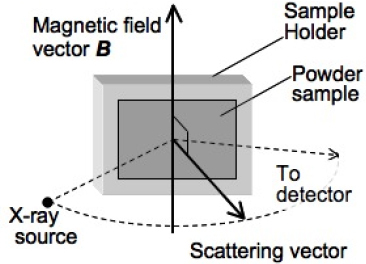Abstract
High-field x-ray diffraction and magnetization measurements and differential thermal analysis (DTA) were carried out for polycrystalline MnBi with an NiAs-type hexagonal structure to investigate its magnetic and structural phase transitions. The lattice parameter a rapidly decreases below the spin reorientation temperature TSR(=90 K) in a zero magnetic field. The parameter c decreases gradually with decreasing temperature and exhibits an anomaly in the vicinity of TSR. By applying a magnetic field of 5 T, the parameter a increases by ∼0.05% when T<TSR and varies smoothly when 8≤T≤300 K. DTA data show that the magnetic phase transition temperature from the ferromagnetic state to the paramagnetic state increases linearly at a rate of 2 KT−1 with increasing magnetic field up to 14 T.
Introduction
The intermetallic compound MnBi with an NiAs-type hexagonal structure (low-temperature phase: LTP) exhibits unique magnetic and structural properties [Citation1–3]. The magnetic moment m of LTP can be extrapolated to a value of 3.9 μB Mn−1 at 0 K [Citation4, Citation5]. With increasing temperature from room temperature (RT), LTP-MnBi undergoes a first-order magnetic phase transition from the ferromagnetic (FM) state to the paramagnetic (PM) state at Tt∼630 K, accompanied by a structural transformation from the NiAs-type to a distorted Ni2In-type hexagonal structure (high-temperature phase: HTP) [Citation5]. The cell volume slightly decreases (<0.1%) in the transformation from LTP to HTP. Chen reported that HTP-MnBi is a separate compound with a chemical formula of Mn1.08Bi [Citation6]. According to the Mn–Bi phase diagram [Citation6], the phase transition of MnBi at Tt upon heating is associated with the peritectic decomposition of MnBi (LTP) into Mn1.08Bi (HTP) and liquid Bi. Recently, on the basis of magnetic measurements for MnBi, Liu et al [Citation7] reported that Tt increases linearly with increasing magnetic field up to 10 T at a rate of ∼2 KT−1. Differential thermal analysis (DTA) performed by Koyama et al [Citation8] also showed an increase in Tt with increasing magnetic field at a rate of 2 KT−1. In addition, they observed a metamagnetic phase transition between the PM state and a field-induced ferromagnetic (FFM) state in the vicinity of Tt [Citation9]. These results suggest that the first-order phase transition with the peritectic composition and the decomposition of MnBi into Mn1.08Bi can be controlled by a magnetic field.
On the other hand, LTP-MnBi undergoes a spin reorientation transition at ∼90 K. At RT, LTP-MnBi has uniaxial magnetic anisotropy along the c-axis [Citation3]. The anisotropy constant decreases with decreasing temperature from RT, and becomes negative at ∼90 K (TSR) [Citation3]. The magnetic moment lies in the c-plane below TSR. This spin reorientation was also observed by neutron diffraction [Citation10, Citation11] and nuclear magnetic resonance (NMR) [Citation12] measurements on LTP-MnBi. However, the relation between the magnetic and structural properties has not yet been clarified in detail [Citation10–13].
In this paper, we present the results obtained for the structural and magnetic properties of LTP-MnBi, which were investigated by measuring high-field x-ray diffraction at a low temperature, magnetization measurements and by DTA.
Experimental
Polycrystalline MnBi was prepared by arc-melting a mixture of stoichiometric amounts of pure elements (Mn, 3N; Bi, 5N) in an argon atmosphere. The obtained button ingot was turned over and remelted several times. After that, the ingot was annealed at 573 K for 5 h in a quartz tube with an argon atmosphere and then quenched in water. X-ray powder diffraction measurements were carried out using CuKα radiation at RT. The sample was confirmed to be LTP-MnBi with small amounts of Bi and Mn, and we did not observe the reflection peaks of HTP-MnBi.
The magnetization M measurement was carried out below RT using a superconducting quantum interference device (SQUID) magnetometer. For 300≤T≤680 K, M was measured using a Faraday force magnetometer in a magnetic field B of up to 10 T. The Faraday force magnetometer was described in [Citation9] in detail. DTA was carried out under an argon atmosphere (ambient pressure) for 300≤T≤773 K and B≤14 T. In this measurement, Al2O3 is utilized as a reference sample. A detailed description of high-field DTA can be found in [Citation14].
High-field powder x-ray diffraction experiments were carried out using CuKα radiation at 8≤T≤300 K using a Gifford-McMahon (GM) type cryocooler (helium gas closed-cycle refrigerator) and for B≤5 T using a cryocooled split-pair superconducting magnet [Citation15]. The cryocooled superconducting magnet generates magnetic fields in the vertical direction. The x-ray scattering vector is in the horizontal direction (figure ). A powder sample was fixed using Apiezon grease on a copper boat holder, which was attached to the second stage of the GM cryocooler in the cryostat. We confirmed that the powder sample was not removed by the magnetic force. The diffraction data were obtained for 20°≤2θ≤100° with a step size of 0.01°.
Results and discussion
Magnetic and structural properties at low temperature
Figure shows the temperature dependence of the magnetization (M–T curves) of MnBi at B=0.4 and 5 T when 5≤T≤300 K. For B=0.4 T, we can see a cusp on the M–T curve at 90 K(=TSR), indicating that the spin reorientation occurs. For B=5 T, the cusp was suppressed, and the magnetization decreases with increasing temperature. This result is consistent with a previous report [Citation7]. Yoshida et al [Citation13] observed thermal hysteresis in the temperature variation of the AC permeability of MnBi in the vicinity of TSR and suggested that the spin reorientation transition is of the first order.
Figure 2 Temperature dependence of the magnetization of MnBi in magnetic fields of 0.4 and 5 T. The vertical arrow indicates the previously determined spin reorientation temperature TSR.
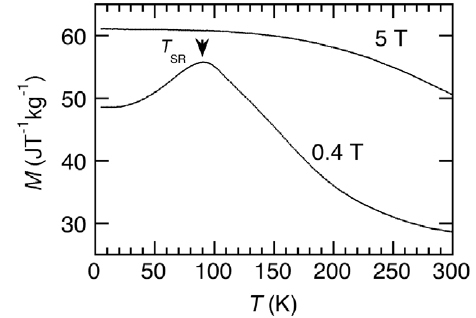
Figure (a) shows the powder x-ray diffraction patterns of LTP-MnBi at 292 K for B=0 and 4 T. For B=4 T, the 300 and 220 peaks are enhanced, though the hkl peaks are suppressed except for the 211 and 311 peaks. Because LTP-MnBi has uniaxial magnetic anisotropy along the c-axis at RT [Citation3], most of the powder in the grease was aligned by the magnetic field, causing the enhancement of the 300 and 220 peaks. However, the 211 and 311 peaks are still observed, indicating that not all the powder was perfectly aligned by the magnetic field of 5 T. As shown in figure (a), the aligned powder remains even at a zero magnetic field. Subsequently, we carried out x-ray diffraction measurements under various temperatures and magnetic fields using this aligned sample. As examples of typical results, the powder x-ray diffraction patterns of MnBi at 8 K for B=0 and 5 T are shown in figure (b). These results show that the aligned sample is fixed by the frozen grease at a low temperature. In this study, the lattice parameters a and c were determined using the 300 and 211 peaks.
Figure 3 Powder x-ray diffraction patterns of MnBi in magnetic fields of 0 and 4 T at 292 K (a) and in magnetic fields of 0 and 5 T at 8 K (b).
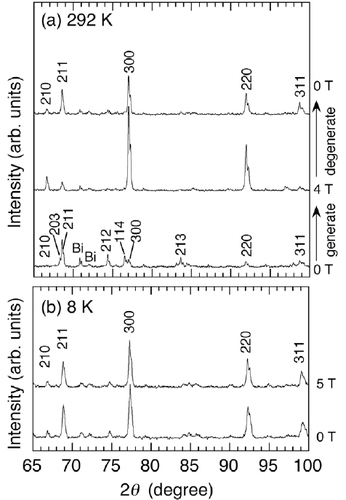
Figure shows the temperature dependences of the lattice parameters a (a) and c (b) and the cell volume V (c) of LTP-MnBi in a zero magnetic field. With decreasing temperature from 300 K, a decreases gradually. Upon further cooling, a decreases rapidly below 130 K (=TSR1), and then it abruptly decreases below 90 K (∼TSR). When T<TSR, a is almost constant. On the other hand, c and V decrease gradually with decreasing temperature and exhibit anomalies in the vicinity of TSR. When T<60 K, the parameter c is larger than immediately above TSR1.
Figure 4 Temperature dependences of the lattice parameters a (a), c (b) and the cell volume V (c) of MnBi in a zero magnetic field. The vertical arrows indicate the characteristic temperatures of the spin reorientation TSR and TSR1. The broken line is a guide to the eyes.
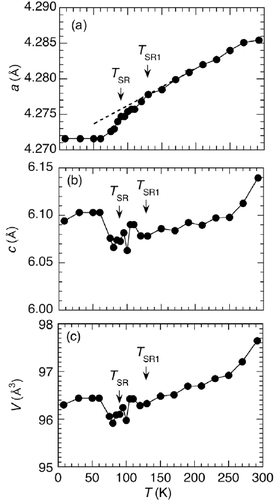
In our experimental configuration (figure ), the enhanced 300 and 220 peaks are mainly due to the magnetically aligned powder, the c-axis of which is parallel to the magnetic field vector. On the other hand, the 211 and 311 peaks are mainly due to the misaligned powder. Therefore, we show the effect of only the magnetic field on the lattice parameter a by estimation from the position of the 300 peak. Figure shows the temperature dependence of a for LTP-MnBi in a magnetic field of 5 T (open circles). Here, data obtained in a zero magnetic field (solid circles) are also illustrated for comparison. The rapid decrease in a when T<TSR1 is recovered by applying a magnetic field of 5 T, and a expands by ∼0.05% for T<70 K.
Figure 5 Temperature dependence of the lattice parameter a of MnBi in 5 T (open circles). The data in a zero magnetic field (solid circles) are also illustrated for comparison.
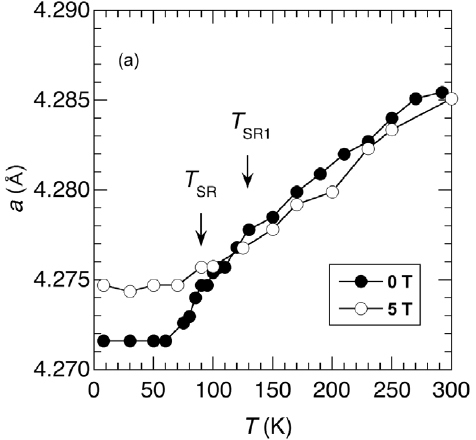
The NMR measurements by Hihara and Kōi show that below 142 K the magnetic moment deviates gradually from the c-axis in LTP-MnBi and enters the c-plane at 90 K [Citation12]. These characteristic temperatures are consistent with TSR1(=130 K) and TSR(=90 K). The rapid decrease in a when T<TSR1 is due to the spin reorientation transition. When T<TSR1, the magnetic moment rotates toward the c-axis upon applying a magnetic field of 5 T to the aligned powder fixed by frozen grease. This field-induced state is similar to the uniaxial state when T>TSR1. Therefore, the lattice parameter a varies smoothly when 10≤T≤300 K under a high magnetic field of 5 T. In this field-induced transition, the interaction between the magnetic field and the spin-orbit coupling probably plays an important role, as pointed out in previous reports [Citation7, Citation11].
According to the report on the effect of pressure on LTP-MnBi by Yoshida et al [Citation13], TSR increases linearly with quasi-hydrostatic pressure P at the rate of dTSR/dP=0.96 K GPa−1. They suggested that the cell volume in the state with the magnetic easy direction along the c-axis is larger than that when the axis is in the c-plane. However, it seems that the volume in both states is not greatly different. On the other hand, the magnetic properties of LTP-MnBi have been explained well by a mean field model with localized magnetic moments [Citation8, Citation16], and the spin-orbit coupling affects the magnetic properties. Therefore, the ratio c/a in the crystal probably plays an important role in the spin reorientation. Measurements in high magnetic fields using an LTP-MnBi single crystal are required for clarifying the magnetic and structural properties in detail.
Magnetic phase transition at high temperature
Figure shows typical results for the DTA curves of MnBi for various B up to 14 T [Citation8]. The data were obtained during heating at a rate of 3 K min−1. For B=0 T, three endothermic peaks were observed at TmBi=533 K (the melting point of Bi), Tt=628 K (the phase transition from LTP to HTP) and TmMnBi=719 K (the peritectic temperature of HTP). Here, these transition temperatures were determined by the onset of the endothermic peaks. Note that TmBi and TmMnBi are independent of B, but Tt increases with increasing B.
Figure 6 DTA curves for MnBi in various magnetic fields up to 14 T [Citation8]. The data were obtained during heating. The vertical arrows indicate the previously determined phase transition temperatures.
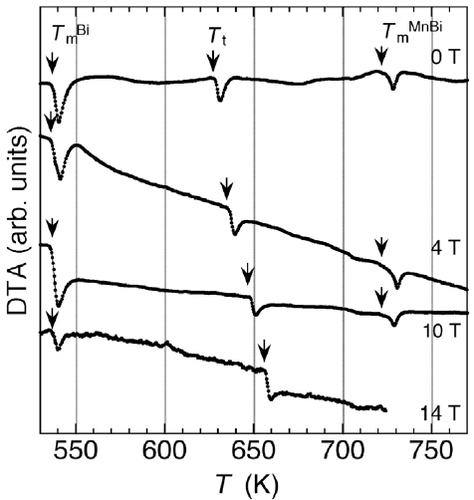
Figure shows typical results for the M–T curves in the vicinity of Tt [Citation9]. Here, the data were also obtained during heating. In this figure, the vertical arrows indicate the previously determined magnetic phase transition temperatures. With increasing T, M abruptly vanishes at Tt even in higher magnetic fields, which indicates that the magnetic transition is of the first order. Liu et al [Citation7] reported that the thermal hysteresis of Tt is about 10 K.
Figure 7 Temperature dependence of the magnetization of MnBi in various magnetic fields up to 10 T in the vicinity of the magnetic phase transition temperature, Tt [Citation9]. The vertical arrows indicate the previously determined Tt.

Figure shows the magnetic field dependence of Tt for MnBi. Upon increasing B up to 14 T, Tt, as determined by DTA measurements, increases linearly by 2 KT−1, although the data [Citation9] obtained from the M–T curves are somewhat scattered. These results show that the endothermic peak at Tt in figure is due to the first-order magnetic phase transition from the FM state to the PM state.
Figure 8 Magnetic phase diagram of MnBi. The solid and open circles indicate Tt determined by DTA [Citation8] and the magnetic measurement [Citation9] data, respectively. The solid diamonds indicate the peritectic temperature TmMnBi determined by the DTA data. The broken lines indicate the extrapolation calculated by the least-squares method for Tt and TmMnBi using the data determined by DTA.
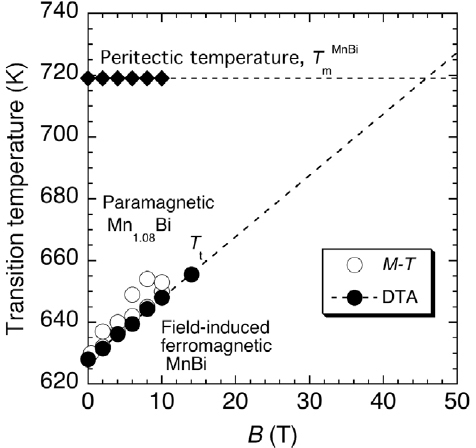
As shown in figure , the only single endothermic peak at Tt in the DTA data shifts to a higher temperature with increasing B, and no extra peak was observed in the vicinity of Tt. This suggests that the structural transformation during the peritectic decomposition is induced by the magnetic field and is accompanied by a first-order magnetic phase transition. That is, the magnetic field affects the first-order magnetic and structural transitions between FM-MnBi with the NiAs-type structure (LTP) and PM-Mn1.08Bi with the distorted Ni2In-type structure (HTP). The transition at Tt probably occurs to minimize the magnetic and elastic energies between FM-LTP MnBi and PM-HTP Mn1.08Bi. Upon applying a magnetic field to the compound, the decrease in the magnetic free energy of FM (FFM)-LTP MnBi is much larger than that of PM-HTP Mn1.08Bi because of the addition of the Zeeman energy. Therefore, we observe the increase in Tt by applying a magnetic field to this compound.
The mean field calculation shows that the Curie temperature TC of LTP-MnBi is ∼720 K [Citation8, Citation16]. In addition, Tt linearly increases at a rate of 2–2.3 KT−1 in fields up to 14 T, as shown in figure . Assuming that this rate is constant at higher temperatures and in higher magnetic fields, Tt will reach the peritectic temperature (TmMnBi∼720 K) of HTP upon applying a magnetic field of ∼45 T. Our mean field calculation suggested that the field-induced magnetic moment of LTP-MnBi is approximately 2 μB Mn−1 in a magnetic field of 45 T at 720 K [Citation8]. This means that we may control the first-order magnetic and structural transitions of MnBi up to the peritectic temperature TmMnBi and solidify MnBi using a high magnetic field without inducing the PM phase. Therefore, from the point of view of magnetoscience, the control of the magnetic and structural properties and the chemical formula and the synthesis of the magnetic material MnBi under high magnetic fields are expected to be of considerable interest.
Summary
We carried out high-field x-ray diffraction and magnetization measurements and DTA for polycrystalline MnBi with the NiAs-type hexagonal structure. For B=0 T, upon decreasing the temperature from room temperature, the lattice parameter a decreases rapidly below 140 K and is almost constant at temperatures below the spin reorientation temperature TSR (=90 K). The parameter c decreases gradually with decreasing temperature and exhibits an anomaly in the vicinity of TSR. By applying a magnetic field of 5 T, the lattice parameter a increases by ∼0.05% when T<TSR and varies smoothly when 10≤T≤300 K. On the other hand, the magnetic phase transition temperature Tt from the ferromagnetic state to the paramagnetic state is 628 K in a zero magnetic field and linearly increases with field strength up to 14 T at a rate of 2 KT−1. The obtained results suggest that we can control the unit cell dimensions for MnBi when T<TSR, and its structural properties and chemical formula when T>Tt by applying a high magnetic field.
Acknowledgments
The high-field x-ray diffraction, the magnetization measurement using the Faraday force magnetometer, and the high-field DTA experiments were carried out at the High Field Laboratory for Superconducting Materials, Institute for Materials Research, Tohoku University. The magnetization measurement using the SQUID magnetometer was performed at the Center for Low Temperature Science, Tohoku University. The authors are very much indebted to Dr H Yoshida for valuable discussions regarding the sample preparation. This work was partly supported by a Grant-in-Aid for Scientific Research from the Ministry of Education, Culture, Sports, Science and Technology, Japan, by the Iketani Science and Technology Foundation, and by the Nippon Sheet Glass Foundation for Materials Science and Engineering.
References
- GullaudC 1951J. Phys. Radium12143 http://dx.doi.org/10.1051/jphysrad:01951001202014300
- GullaudC 1951J. Phys. Radium12223 http://dx.doi.org/10.1051/jphysrad:01951001203022300
- GullaudC 1951J. Phys. Radium12492 http://dx.doi.org/10.1051/jphysrad:01951001203049200
- HeikesR R 1955Phys. Rev.99446 http://dx.doi.org/10.1103/PhysRev.99.446
- RobertsB W 1956Phys. Rev.104607 http://dx.doi.org/10.1103/PhysRev.104.607
- ChenT 1974J. Appl. Phys.452358 http://dx.doi.org/10.1063/1.1663594
- LiuYZhangJCaoSJiaGZhangXRenZLiXJingCDengK 2006Solid State Commun.138104 http://dx.doi.org/10.1016/j.ssc.2006.01.050
- KoyamaKOnogiTMitsuiYNakamoriYOrimoSWatanabeK 2007Mater. Trans.482414 http://dx.doi.org/10.2320/matertrans.MAW200721
- OnogiTKoyamaKWatanabeK 2007J. Japan. Inst. Met.71489 (in Japanese) http://dx.doi.org/10.2320/jinstmet.71.489
- AndersenA FHälgWFischerPStollE 1967Acta Chem. Scan.211543
- YangJ BYelonW BJamesW JCaiQKorneckiMRoySAliNPhl'Heritier 2002J. Phys.: Condens. Matter146509 http://dx.doi.org/10.1088/0953-8984/14/25/318
- HiharaTKōiY 1970J. Phys. Soc. Japan.29343
- YoshidaHShimaTTakahashiTFujimoriHAbeSKanekoTKanomataTSuzukiT 2001J. Alloys Compounds 317297 http://dx.doi.org/10.1016/S0925-8388(00)01352-9
- AwajiSWatanabeKMotokawaM 2001J. Cryst. Growth22683 http://dx.doi.org/10.1016/S0022-0248(01)01273-8
- WatanabeKWatanabeYAwajiSFujiwaraMKobayashiNHasebeT 1998Adv. Cryog. Eng.44747
- HubermanB AStreiferW 1975Phys. Rev.B 122741 http://dx.doi.org/10.1103/PhysRevB.12.2741
